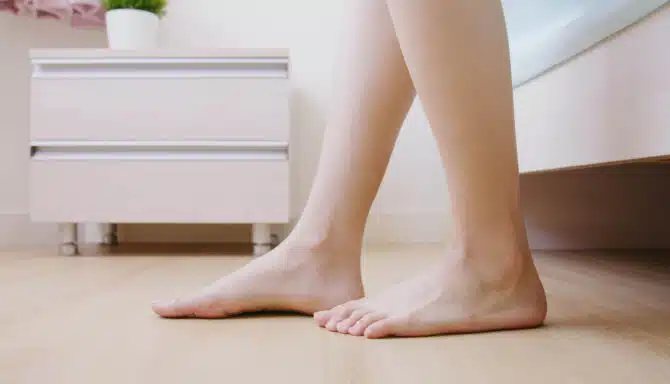Your feet hurt, your muscles ache, and your joints are sore. What’s going on?
If you experience pain on the top of your foot, there are a number of injuries that may be the culprit.
Pain on the top of your foot is a relatively broad term. That’s because there are so many different issues that can arise from the foundation of our bodies. We do after all use our feet every day. Typically, one injury can lead to another as well, given the interconnectedness of our muscles, joints, and tendons.
Below we outline four common injuries and reasons you may be experiencing pain on top of your foot.
Tendonitis
Tendonitis is inflammation or irritation of a tendon. For those experiencing top-of-foot pain, tendinitis of the tibialis anterior tendon may be the cause. The tibialis anterior is a far-reaching muscle that originates two-thirds up your lower leg, and extends down to the top of your foot and connects to your metatarsal bones.
Another source of tendinitis may be in your extensor tendons, which wraps across your ankle and extend through the top of your foot. These tendons sit between the bones and the skin, making them prone to injury, and aggravation because of tight shoes. Tightness, overuse, friction, and improper fitting shoes can all be contributing factors.
With all tendinitis, the best course of action includes rest, icing to reduce inflammation, anti-inflammatories for the same reason, and toe grip exercises. If the root of the problem is improper shoes, visit the clinic for a foot assessment and we’ll get you into the proper footwear.
Bone spur
Bone spurs are bony outgrowths as a result of osteoarthritis. Although heel spurs are common, pain specifically on the top of your foot is more likely a toe spur.
As your joint cartilage breaks down, your body responds by growing additional bone as a defence mechanism. Bone spurs develop in order to fortify and stabilize the joint by building additional calcium deposits. Because of the outgrowth, there are a number of symptoms that arise.
Symptoms of a bone spur – also known as osteophyte – include pain, stiffness, tenderness, loss of flexibility, grating sensations, swelling, and seeing bony projection itself.

These symptoms are particularly prevalent in athletes who participate in high-impact sports. Those who run, or do gymnastics and ballet are particularly prone, as are older people. Symptoms may get worse over time if not addressed. Plus, you may experience any combination of these symptoms.
Treatment isn’t always necessary, since a bone spur may not cause you any pain or reduce your quality of life. If you experience pain, visit a professional to get a proper diagnosis and treatment.
You cannot remove the bone spur without surgery. But, if you fix the problem at its root, and take certain precautionary steps, bone spurs won’t necessarily be painful, and surgery won’t be necessary. In any case, surgery is a short-term solution as a bone spur can re-develop. Certain treatments include weight loss, changing shoes, hot and cold therapy to reduce inflammation, and anti-inflammatories.
If you do require surgery, the course of action is to either remove the bone spur entirely or to fuse the bones together. Recovery time can vary, and as always, it’s best to consult a healthcare professional for a proper diagnosis.
Read more: All You Need To Know About Bone Spurs.
Stress fracture(s)
If the pain is sharp, you may have a stress fracture. A common area of stress fractures is within the area of your midfoot, where your metatarsals are located.
They are the first metatarsal, second metatarsal, third metatarsal, fourth metatarsal, and the fifth metatarsal. These bones connect your toes, and are put under pressure during high-impact activities like running.
You may also be experiencing metatarsalgia, a more general term used for any pain found in the ball of the foot, where the metatarsals of the foot lie. This pain often occurs under the second and third metatarsals. In that case, wear shoes with a low heel and a wider toe box to reduce stress to your feet.
If the root problem is faulty foot mechanics, corrective custom foot orthotics will help to increase support and stability in the foot and ankle as well as redistribute plantar pressures.
Neuroma
Neuroma is a benign growth of nerve tissue frequently found between the third and fourth toes, often referred to as a ‘pinched nerve’, according to the Mayo Clinic. You may experience pain in the ball of your foot, a burning sensation, or tingling, depending on the severity. Similarly, it can feel like you’re walking with a pebble in your shoe.
Causes of neuroma include biomechanical deficiencies, trauma, improper footwear, and repeated impact and stress. We encourage you to read more about neuroma on our injury-specific page.
In terms of treatments, simple fixes include:
- Metatarsal pad or neuroma pad – these types of padding are placed under the ball of the foot and act to open the intermetatarsal space and reduce irritation of nerve tissue;
- Wear shoes with wider toe box, and lower heels to reduce pressures applied to the front of the foot;
- Custom foot orthotics – these custom-made devices can help further offload the forefoot and control and biomechanical abnormalities;
- Injection therapy: An alcohol solution can be injected into the nerve site at regular intervals to decrease size and subsequent pain.
If you are experiencing pain at the ball of your foot, book an appointment with one of our licensed chiropodists at Feet First Clinic.








